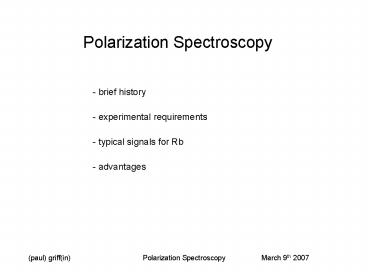Polarisation Spectroscopy - PowerPoint PPT Presentation
1 / 17
Title:
Polarisation Spectroscopy
Description:
creates an anisotropy of mF populations. Probe with linear polarized light ... Test for an anisotropy in medium. Interrogate circular components of probe beam ... – PowerPoint PPT presentation
Number of Views:57
Avg rating:3.0/5.0
Title: Polarisation Spectroscopy
1
Polarization Spectroscopy
- brief history
- experimental requirements
- typical signals for Rb
- advantages
2
Laser spectroscopy
Laser invented in 1960s
FM spectroscopy in 1980s
- these techniques are all very new and still
under development
- often if you have a problem the answer is not
known - share the knowledge
3
The blurb
The experiments themselves - saturation
spectroscopy, polarization spectroscopy - were
magnificent in their design and execution
J. S. Rigden, Hydrogen The Essential Element
(Harvard University Press, 2003), pp. 209.
4
Principle
- to induce a birefringence in the atomic medium
Pump with circularly polarized light - creates
an anisotropy of mF populations
Probe with linear polarized light - observe
rotation of polarization
C Wieman and T W Hänsch. Phys. Rev. Lett. 36 1170
(1976) W Demtröder Laser Spectroscopy 2nd edn
(Berlin Springer) 1998 Polarization
spectroscopy of a closed atomic transition
applications to laser frequency lockingC. P.
Pearman, et al. J. Phys. B 35, 5141 (2002)
5
Optical set-up
6
Optical set-up
7
Optical set-up
- pumpprobe spectroscopy
- very similar to normal saturation absorption
spectroscopy
- Pump beam circularly polarized to drive s
transitions.
- Probe beam is aligned at p/4 so that in absence
of pump equal intensities are measured at both
photodiodes.
- Approximate intensities of Isat for probe and
3Isat for pump
NOTE
- windows on vapor cells are birefringent due to
stress - feedback from other elements (including
pump beam) can be polarization dependent
8
Model
Strong pump
Weak probe
9
Kramers Kronig relation
? ?r ??i
- Differential absorption
- different refractive indices experienced by s
components - Medium is birefringent
10
Signal
Separating probe into horizontal and vertical
components
Da0 maximum difference in absorption between
polarisation components at line centre Dn
difference in refractive indices of circularly
polarised components of probe. G absorption
linewidth w0 resonant frequency L
length of cell
C. P. Pearman, et al. J. Phys. B 35, 5141
(2002) ML Harris, et al. Phys Rev A 73, 062509
(2006)
11
Test for an anisotropy in medium
Interrogate circular components of probe beam
- put a ?/4 plate before final PBS - this
converts LH and RH circular components into linear
12
Signals
Small angle (5 mrad) between pump and probe beams
Deliberately Doppler broadened signals (72 mrad
between beams)
13
Locking a laser
- Error signal with only a simple op-amp
difference circuit and no filtering or
de-modulation
-550 MHz
- Huge re-capture range if laser is perturbed
while maintaining Doppler-free resolution.
Zero crossings -920 MHz, 220 MHz
14
Improvements Mu-metal
Caveats - care with alignment as mu-metal can
create huge magnetic field gradients - with use
of good shield and a long solenoid to apply
uniform bias field then very clean signals can be
obtained.
15
Laser Linewidth
2 lasers locked to 85Rb F3 ? F4 using only I
lock to piezo
FWHM 625 kHz
- Individual linewidths of 300 kHz
- Assuming un-correlated, equal in magnitude laser
linewidths. Correlated drifts e.g. due to
temperatures would not be evident with this
method of measuring linewidths.
16
Comparisons for locking to Rb
17
Advantages
Modulation free locking
Common mode rejection of laser intensity due to
subtraction of signals
Low cost particularly compared to FM saturation
absorption spectroscopy






























